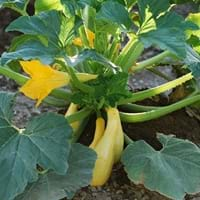What is
Life Span
Perennial
Annual
Type
Perennial
Vegetable
Origin
California
Hybrid origin, North America, Mexico, Central America
Types
Not Available
Not Available
Habitat
Chaparral, River side
Not Available
USDA Hardiness Zone
7-10
Not Available
AHS Heat Zone
9-1
12-1
Sunset Zone
H1, 4, 5, 6, 7, 8, 9, 10, 11, 12, 14, 15, 16, 17, 18, 19, 20, 21, 22, 23, 24
A1, A2, A3, H1, H2, 1a, 1b, 2a, 2b, 3a, 3b, 4, 5, 6, 7, 8, 9, 10, 11, 12, 13, 14, 15, 16, 17, 18, 19, 20, 21, 22, 23, 24
Habit
Upright/Erect
Vining/Climbing
Information
Plant Size
Minimum Height
120.00 cm
99+
60.00 cm
99+
Minimum Width
Not Available
90.00 cm
99+
Plant Color
Flower Color
White, Yellow
Yellow, Orange
Flower Color Modifier
Bicolor
Bicolor
Fruit Color
Green, Tan
Yellow
Leaf Color in Spring
Gray Green
Green
Leaf Color in Summer
Gray Green
Green, Dark Green
Leaf Color in Fall
Gray Green
Green, Dark Green
Leaf Color in Winter
Light Green
Not Available
Shape
Leaf Shape
Lance shaped
Heart-shaped
Thorns
Yes
No
Season
Plant Season
Spring, Summer
Summer, Fall
Growing Conditions
Sunlight
Full Sun
Full Sun
Growth Rate
Fast
Very Fast
Type of Soil
Loam, Sand
Loam, Sand
The pH of Soil
Neutral, Alkaline
Neutral
Soil Drainage
Well drained
Well drained
Bloom Time
Early Spring, Spring, Late Spring, Early Summer, Summer
Indeterminate
Repeat Bloomer
Yes
Yes
Tolerances
Drought
Drought
Care
Where to Plant?
Ground
Container, Ground
How to Plant?
Cuttings, Seedlings
Divison
Plant Maintenance
Medium
Medium
Watering Plants
Watering Requirements
Needs watering once a week, Water well when planted
Do not water frequently
In Summer
Lots of watering
Lots of watering
In Spring
Moderate
Moderate
In Winter
Average Water
Average Water
Soil
Soil pH
Neutral, Alkaline
Neutral
Soil Type
Loam, Sand
Loam, Sand
Soil Drainage Capacity
Well drained
Well drained
Sun Exposure
Full Sun
Full Sun
Pruning
prune nearly to the ground in late fall
Remove dead or diseased plant parts, Requires very little pruning
Fertilizers
organic fertlizers
All-Purpose Liquid Fertilizer
Pests and Diseases
Verticillium Wilt
Borers, Cucumber beetles, Mealybugs, Powdery mildew
Plant Tolerance
Drought
Drought
Facts
Flowers
Showy
Yes
Flower Petal Number
Single
Single
Fruits
Showy Fruit
No
Yes
Edible Fruit
No
Yes
Fragrance
Fragrant Flower
Yes
Yes
Fragrant Fruit
No
No
Fragrant Leaf
No
No
Fragrant Bark/Stem
No
No
Showy Foliage
Not Available
No
Showy Bark
Yes
No
Foliage Texture
Not Available
Coarse
Foliage Sheen
Not Available
Matte
Evergreen
No
No
Invasive
Sometimes
No
Self-Sowing
No
Yes
Attracts
Bees, Birds, Butterflies
Not Available
Allergy
no allergic reactions
Not Available
Benefits
Uses
Aesthetic Uses
Showy Purposes
Not Used For Aesthetic Purpose
Beauty Benefits
Not Available
Not Available
Edible Uses
Yes
Yes
Environmental Uses
Air purification
Air purification
Plant Benefits
Medicinal Uses
antimicrobial, Astringent, Gum Problems, Stomach pain
Not Available
Part of Plant Used
Flower Stalk
Fruits
Other Uses
Used as Ornamental plant
Used as a nutritious food item, Used As Food
Used As Indoor Plant
No
No
Used As Outdoor Plant
Yes
Yes
Garden Design
Feature Plant, Groundcover, Mixed Border, Wildflower
Edible, Herb / Vegetable, Vine
Scientific Name
Botanical Name
ROMNEYA coulteri
CUCURBITA pepo 'Papaya Pear'
Common Name
Matilija Poppy
Summer Squash
In Hindi
Matilija Poppy
summer squash
In German
Matilija Poppy
Sommerkürbis
In French
Matilija Poppy
courges d'été
In Spanish
Matilija amapola
calabaza de verano
In Greek
Matilija παπαρούνας
καλοκαίρι σκουός
In Portuguese
Matilija Poppy
abobrinha
In Polish
Matilija Poppy
latem squash
In Latin
Matilija Poppy
aestas cucurbitae
Classification
Kingdom
Plantae
Plantae
Phylum
Magnoliophyta
Magnoliophyta
Class
Magnoliopsida
Magnoliopsida
Order
Papaverales
Violales
Family
Papaveraceae
Cucurbitaceae
Genus
Romneya
Cucurbita
Clade
Angiosperms, Eudicots
Angiosperms, Eudicots, Rosids
Tribe
Not Available
Cucurbiteae
Subfamily
Papaveroideae
Cucurbitoideae
Number of Species
2
99+
5
99+
|
||
|
||
|












